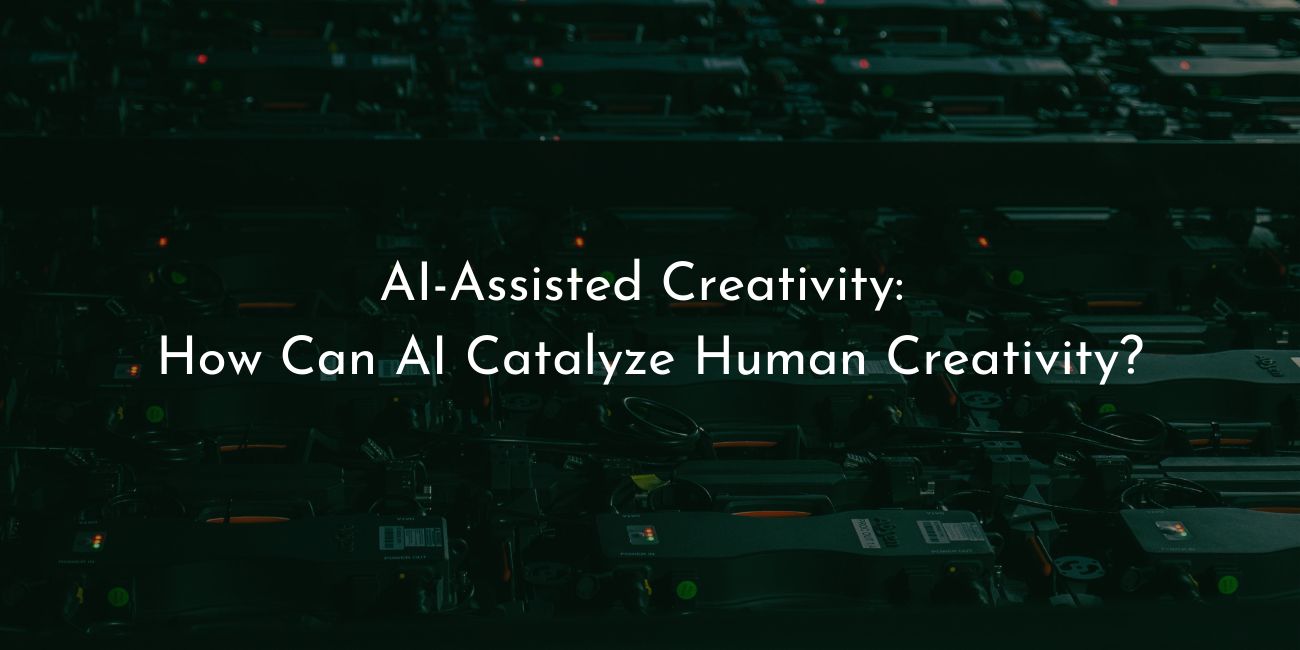AI-Assisted Creativity is the utilization of Artificial Intelligence (AI) in augmenting and catalyzing creativity. The use of AI drives the imagination and generates new ideas, concepts, and designs that were often not conceivable before. AI-Assisted Creativity is not about replacing people but enhancing people’s potential by providing an exciting new toolset that inspires, guides, and facilitates creativity. Artificial Intelligence Arts is achievable by utilizing advanced algorithms that mimic, break down, and extend discovered patterns in outputs, such as music, literature, and art.
AI catalyzes human creativity in a myriad of manners. An AI creative’s routinary tasks are automated. allowing the actual work to become the focal point of the project. AI creates original vantage points by producing novel combinations from pre-existing ideas, promoting creativity and innovation. AI assists in evaluating creative outputs, using analysis powered by AI to offer objective critiques and suggest improvements.
The benefits of AI-Assisted Creativity are many-fold. Improvement in efficiency, novel idea generation, distinctive creation, and democratization of tools are a few examples. AI allows anyone to express their creativity using advanced tool sets that were once only available to experts, regardless of their skill level.
Over-reliance on AI is a limitation that leads to a homogenization of outputs, reinforcing existing biases and trends. Devaluation of human artistry has the probability of undermining the uniqueness and value of human-made creations with AI-generated outputs. The future of AI-Assisted Creativity is wide-reaching, but it is essential to balance AI’s involvement with preserving and valuing the irreplaceable human touch in creativity.
What Does AI-Assisted Creativity Mean?
AI-Assisted Creativity is a modern paradigm where Artificial Intelligence (AI) technologies are used to bolster, stimulate, and enrich human creativity. AI-Assisted Creativity doesn’t suggest replacing human creatives. AI-Assisted Creativity involves AI serving as an augmentative tool, enhancing the creative process through pattern recognition, data analysis, and generative capabilities that inspire and facilitate unique artistic outputs.
An AI creative in the arts field utilizes algorithms that generate unique paintings based on learned styles from thousands of artworks. An AI creative in music utilizes AI to compose original pieces by learning and extrapolating from various musical genres.
AI creative tools automate routine tasks for graphic designers, generate innovative design concepts, and provide intelligent suggestions based on the analysis of current design trends.
AI-Assisted Creativity signifies a compelling blend of technology and human creativity, where AI acts as a collaborator, offering novel possibilities and perspectives, driving the evolution of artistic expression and design.
How Can AI Assist Human Creativity?
AI-Assisted Creativity uses Artificial Intelligence (AI) technologies to augment and stimulate human inventiveness. Artificial Intelligence Arts use machine learning in discerning, replicating, and extending patterns found in creative projects. Machine learning algorithms learn and train on enormous datasets, representing a multitude of art forms.
The process of AI training involves the AI studying and breaking down datasets, pinpointing underlying patterns, structures, and principles, and using the accumulated learnings in the production of wholly original outcomes. AI learns the nuances of melody, rhythm, and harmony and concocts original pieces in a similar manner by feeding AI an extensive corpus of music.
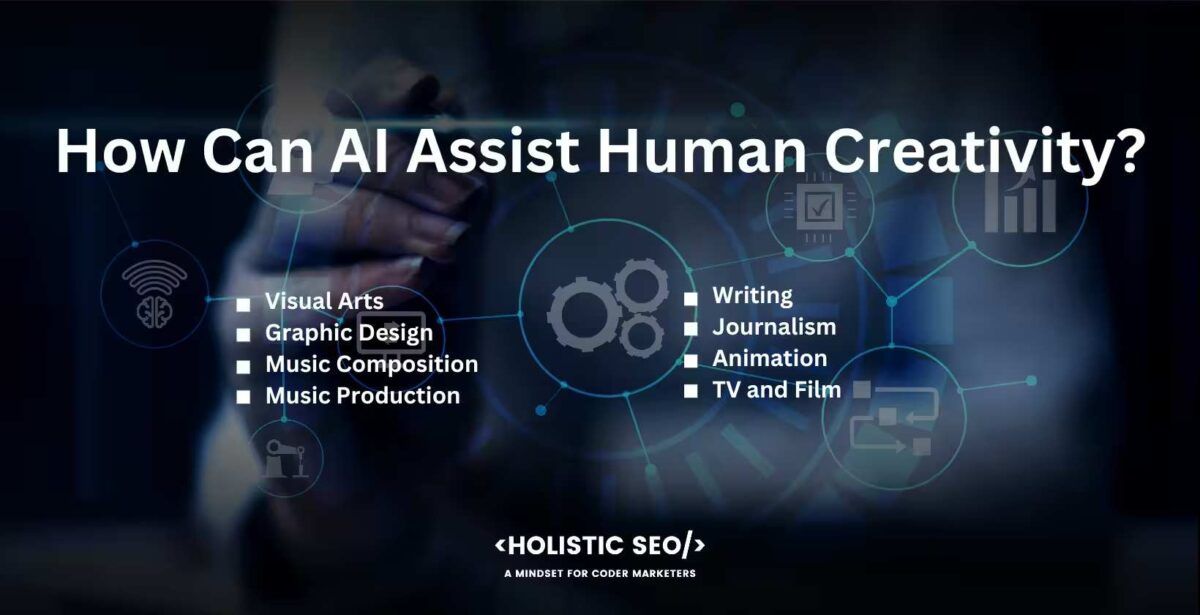
AI analyzes countless artworks or graphic designs, grasps the essential elements and styles, and produces new artwork or designs echoing those styles yet remaining distinct. AI assists human creativity by providing a unique set of capabilities that inspire, guide, and improve inventiveness, offering a powerful new toolset for artists to explore and exploit.
What Are the Different Human Creativity AI Can Assist?
Listed below are different areas AI can assist with human creativity.
- Visual Arts: Generative Adversarial Networks (GANs) allow artists to produce wholly original images by absorbing vast datasets of preexisting artwork. GANs replicate styles from famous painters, for example, pushing the boundaries of human artistic expression.
- Graphic Design: AI automation is used by graphic designers for tasks such as resizing and formatting, which significantly helps artists cut production time. AI provides inspiration by generating potential design concepts or by analyzing current design trends and providing intelligent suggestions. AI frees up designers’ time to focus on more strategic and creative tasks while offering new sources of inspiration.
- Music Composition: Musicians use AI to compose, perform, and even master tracks. Algorithms analyze vast music libraries to learn the underlying structures of melody, harmony, rhythm, and more. AI generates entirely new compositions in various styles and hybrid genres that blend different musical traditions.
- Music Production: AI aids in music production by mastering tracks, adjusting the balance and EQ to ensure the best sound quality. AI is even starting to perform music providing exciting new performance possibilities with AI-driven robots playing instruments in ways that humans are incapable of.
- Writing: Natural Language Generation (NLG) algorithms produce written content that closely mimics human writing. Content written through NLG algorithms ranges from simple summaries and reports to complex narratives and poetry. AI creates writing prompts, providing authors with new sources of inspiration.
- Journalism: Journalists utilize AI to automate routine reporting, especially for areas like financial news or sports results. AI allows journalists to focus on more complex and investigative stories while ensuring that routine reporting is done quickly and accurately.
- Animation: AI algorithms automate various aspects of the animation process, from generating backgrounds to animating characters, speeding up production times and allowing for more complex scenes. AI additionally aids in scriptwriting by analyzing successful scripts and generating new ones based on learned patterns.
- TV and Film: AI is beneficial in post-production for tasks like color grading, sound editing, and special effects. AI not only speeds up the filmmaking process but allows filmmakers to experiment with new techniques and styles.
How Is AI Transforming the Field of Creativity?
AI is profoundly transforming the field of creativity by opening up new avenues for innovation and expression. Musical composers use the process “AI create”, which learns and mimics different styles and genres from vast libraries of songs. AI algorithms compose wholly original music pieces reflecting the learned styles once trained, enabling the creation of unique compositions and even hybrid genres.
Visual artists utilize AI create by using GANs to generate novel artwork. AI replicates artistic styles from renowned painters or creates entirely new, unique pieces by learning from extensive datasets of existing artworks.
AI even collaborates with human artists, providing a creative springboard and leading to a fusion of human and AI art. AI greatly transforms the creative process by allowing all types of creators to put most of their effort into their actual art. AI introduces an unparalleled level of innovation and diversity in creative outputs.
AI is not replacing human creativity but catalyzing and augmenting it, ushering in a new era of AI-Assisted Creativity.
What Are the Ways AI Can Catalyze Human Creativity?
Listed below are the ways AI can catalyze human creativity.
- Identify Patterns: AI’s ability to analyze large datasets allows it to uncover patterns, correlations, and trends that are not readily apparent to human creators. AI helps inspire human creators to develop new hypotheses and ideas that are otherwise overlooked by recognizing patterns that were previously unseen. Newly discovered patterns lead to innovative breakthroughs and fresh perspectives that enhance the creative process.
- Provide the Bigger Picture: AI’s data processing capabilities enable it to analyze diverse sets of data and provide a comprehensive understanding of a subject matter, providing a greatly expanded perspective and leading to the opening the creative possibilities for human creators by exposing them to new information, perspectives, and insights. Human creators can develop more informed and well-rounded creative outputs by integrating AI’s insights.
- Guide Experimentation: AI is a valuable guide in the creative process by suggesting potential avenues for exploration and experimentation. AI recommends alternative paths, generates ideas, and provides feedback on creative outputs by leveraging machine learning algorithms. AI’s guidance allows human creators to take calculated risks, push creative boundaries, and iterate on ideas more effectively, enhancing creativity and innovation.
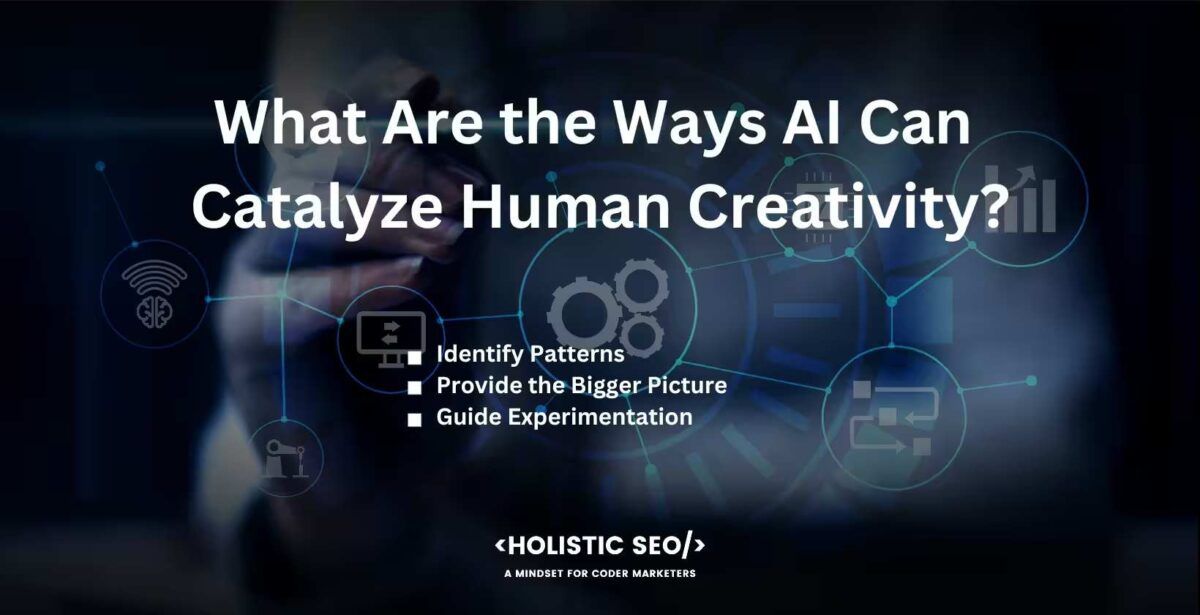
What Role Does AI Play in Enhancing Artistic Expression?
AI’s roles in assisting artistic expression are giving high-value insights, automation, and jump-off points from the start of an artistic process until the end. AI assists by breaking down and investigating enormous datasets to discern near-impossibly predictable correlations, encouraging wholly original ideas and directions for artists.
AI generates suggestions and alternative opportunities and even completes routine actions automatically based on preexisting data, which frees up artists’ time. AI helps artists focus on the minutiae and intricacies of the projects, but AI does not have the creative soul humans have to create beautiful art.
AI is a tool made by humans for humans to use. AI alone is incapable of creating art or expressing itself independently, as It lacks the depth of humanity. AI is incapable of emotions, accumulating experiences, and thinking of subjective interpretation, which is integral to artistic expression.
The future of AI is blindingly bright, but the artistic mind and soul are not replicable. AI only serves as a useful apparatus to elevate what artists want to unleash to the world, but AI is unable to surpass that.
What Are the Benefits of AI-Assisted Creativity?
Listed below are the benefits of AI-Assisted Creativity.
- Enhanced Innovation and Diversified Thought Processes: A benefit of AI-Assisted Creativity is the generation of near-infinite unique combinations and permutations of ideas, fostering an environment of increased creativity. AI helps creators to challenge their own perspectives, push the boundaries of conventional thought, and come up with genuinely innovative concepts. AI models analyze extensive datasets, extract patterns, and generate creative insights that are not obvious to humans, greatly expanding the range of ideas available for creative endeavors.
- Efficiency and Speed: AI-Assisted Creativity is beneficial in accelerating a project’s completion by automating specific tasks like the quick generation of multiple prototypes, designing iterations on existing work, or writing hundreds of ad slogans in a matter of seconds. AI-Assisted Creativity markedly provides massive preservation of time and energy, allowing artists to refine the best ideas further and leave a unique fingerprint. AI algorithms are trainable to create specific types of content based on predefined parameters, enabling the rapid generation of initial concepts for further human refinement.
- Personalized User Experiences: AI’s data analysis capabilities benefit artists, leading to more personalized and impactful creative outcomes. AI analyzes data about the behaviors, preferences, and needs of users and creates tailor-fit messages or design experiences that resonate with each individual user, which is highly valuable for digital marketers. AI’s data analysis capabilities lead to more engaging and compelling creative content. AI generates personalized recommendations or adjusts the storyline of interactive content, such as video games, based on user input, leading to a more immersive experience.
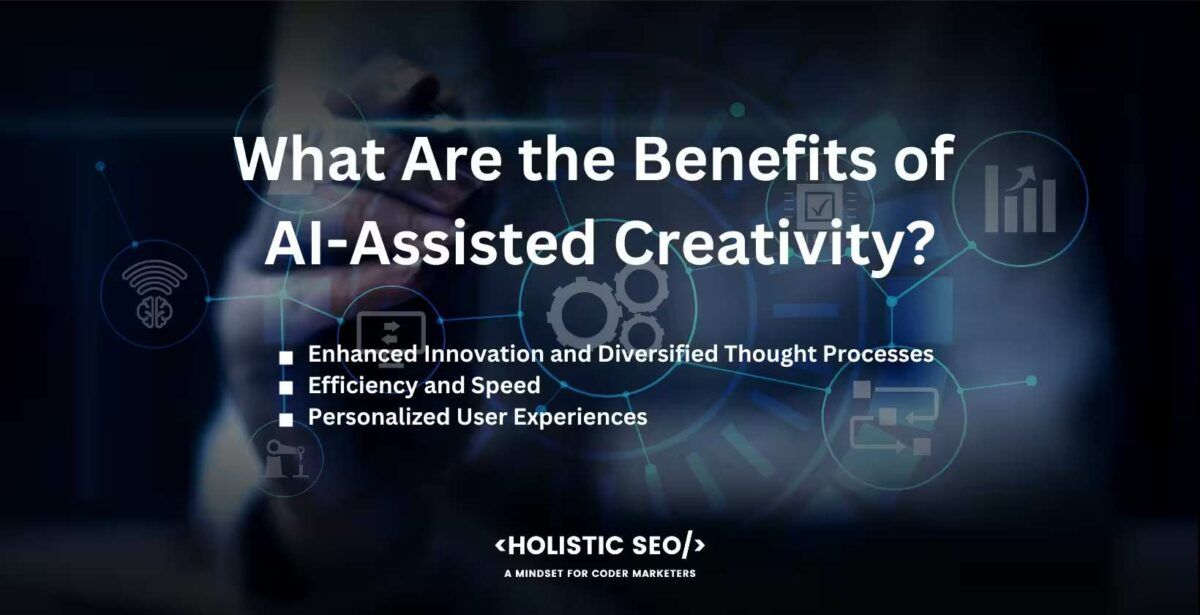
What Are the Potential Drawbacks of AI-Assisted Creativity?
Listed below are the potential drawbacks of AI-Assisted Creativity.
- Lack of Genuine Human Creativity and Emotion: AI’s lack of capability to fully capture the depth of human emotions, subjective experiences, and the unpredictable nature of human creativity. A pure AI output looks beautiful but is still glaringly obvious to observers due to its lack of soul. Art and creativity are innately human expressions, typically born from personal experiences, emotions, and cultural contexts. AI loses and misrepresents these nuances leading to creations that feel artificial or soulless.
- Risk of Homogenization: AI algorithms are only capable of absorbing existing datasets which pose a legitimate risk of perpetuating existing trends, styles, and biases present in the dataset, leading to a lack of diversity and originality in the creative output. Homogenization is a significant limitation because it stifles innovation, ultimately leading to unoriginal and derivative works, which is detrimental to both artists and consumers.
- Ethical and Intellectual Property Concerns: AI raises questions and doubts about authorship, originality, and intellectual property rights as its use becomes significantly widespread across multiple creative industries. The questions such as “If an AI creates a piece of music or a work of art, who owns the copyright?” and “Does ownership of the generated content fall under the creator of the AI, the user who prompted the creation, or the AI itself?” are especially relevant in the advent of the AI revolution. Questions and issues like these are still being debated and do not currently have a definitive resolution.
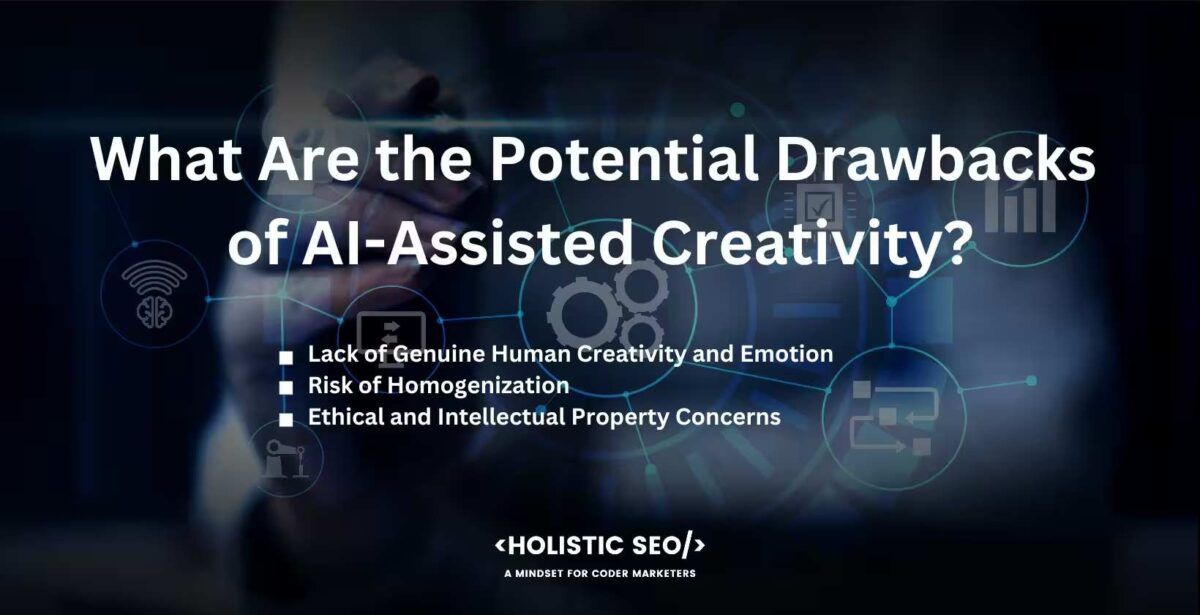
How Does AI Contribute to The Evolution of Creative Industries?
AI contributes to the evolution of creative industries in numerous ways, with the potential for significant long-term effects as AI assistants continue to evolve.
AI tools are becoming more sophisticated, capable of generating high-quality creative content in fields like visual art, music, writing, and design, such as Artistic AI. AI algorithms are becoming more adept at understanding and replicating complex creative tasks, which were once thought exclusive to human ability, as the algorithms continue to adapt and absorb knowledge recursively. AI is expected to handle an increasingly wide range of creative tasks, helping professionals produce a higher volume of work at an improved quality level.
AI’s contribution to the creative process is increasingly moving from a behind-the-scenes tool to a collaborative partner. Future AI assistants are expected to have improved interactivity with suggestions, trend prediction, and exploration of original artistic avenues, greatly helping AI artists. The evolving nature of AI leads to previously unknown forms of expression and wholly original genres that blend human creativity with AI’s unique capabilities.
AI is thought of as a form of cheating that varies depending on one’s perspective. One argument leans towards AI being a form of cheating as it devalues human inventiveness and skill. The different side leans towards AI as just a different tool set artists can use, no different from using a new instrument or a different type of paintbrush. AI is just a tool, and tools are inherently neutral and is solely dependent on how artists usage of AI.
How Can AI Collect Data On Human Preferences and Ideas?
AI collects data on human preferences and ideas through a variety of methods, harnessing the power of machine learning to analyze, interpret collated data, and help with the art AI produces.
AI collects data by tracking and breaking down user interactions across digital platforms. Online activities are studied by AI to infer a person’s preferences and ideas. Examples of online activities are visited websites and links, search engine queries, and social media likes and shares.
AI analyzes user-generated content, including reviews, social media posts, or comments, using a subfield of AI known as natural language processing (NLP), which focuses on the interaction between computers and human language. User-generated content is scrutinized to discover users’ interests, opinions, and sentiments.
AI can utilize responses from surveys and feedback forms. Machine learning algorithms sift through open-ended responses to identify common themes, sentiments, and trends. Data coming from surveys and feedback forms provide a more direct understanding of a user’s preferences and ideas.
AI analyzes e-commerce behavior by collecting a user’s browsing and purchase history to understand user preferences. Inferences are drawn based on the types of products a user frequently buys or the styles or brands users consistently look at. The collected data is used to suggest similar items in the future.
Personal assistants and recommender systems are utilized in data collection. Personal assistants like Amazon’s Alexa, Google Assistant, or Apple’s Siri collect data on user preferences through daily interactions. Recommender systems on platforms like Netflix or Spotify learn from each interaction to understand a user’s taste in movies or music.
AI utilizes Internet of Things (IoT) devices like smartwatches and fitness trackers for data collection. AI gains insights into user lifestyles and habits by analyzing personal data such as daily step count, heart rate, sleep patterns, and more.
It’s important to highlight that the collection and usage of data by AI systems are subject to various privacy laws and regulations. User consent is typically required for data collection, and users must have the option to opt out. Transparency about what data is collected and its use is considered a best practice in AI data collection in all these activities.
What Ethical Concerns with The Use of AI in Creative Ideas?
The use of AI in creativity generates a unique set of ethical concerns. One such concern revolves around the differentiation between human-made and AI-generated art.
Distinguishing between art produced by humans and art generated by AI is increasingly challenging, as AI systems improve sophistication in creative capacities. The blurring of boundaries significantly impacts a person’s perception and valuation of art. Art is traditionally seen as a reflection of human emotion, culture, and experience. AI mimics these reflections and aspects but without the genuine human experiences and emotions underlying it.
The authenticity of the inventive process comes into question. Art keeps its value due to originality and the unequaled human touch in its creation. The human element in art is devalued when differences between art output by humans and AI are imperceptible from each other. Mass production of AI-generated art poses the risk of saturating the market, diminishing the appreciation for the time, effort, and skill invested by real artists.
The advancement of AI-generated art raises concerns about misuse. For example, it increases the difficulty in the authentication and verification of a piece when AI is used to create counterfeit art. AI-generated counterfeit art deceives buyers and heavily undermines the integrity of the art world.
The list of ethical concerns underlines the importance of maintaining a clear distinction between human and AI art, even if AI offers exciting new avenues for inventiveness and artistic expression. The development of regulations and forming of norms are crucial in upholding the unequaled value of human creativity and AI.
What Are the Implications of AI-Generated Content on Copyrighted Properties?
Listed below are the implications of AI-generated content on copyrighted properties.
- Ownership. AI-generated content raises concerns about ownership. For example, it is difficult to properly determine ownership between the AI’s creator, the AI user, the AI itself, or the copyright holder of material from which the output is generated, as these entities all have valid claims.
- Fair Use. AI’s ability to create derivative outputs based on protected properties is shielded by “fair use.” Fair use permits the sparing use of copyrighted materials without authorization, but the extent to which AI-generated content is considered qualified under it is still debatable.
- Infringement Risks. AI has the ability to infringe on existing copyrights, especially if it’s trained on copyrighted material. For example, an output produced by AI that’s too similar to copyrighted works, even if it wasn’t explicitly programmed, is subject to infringement.
- Enforcement Challenges. The automatic and high-volume nature of AI-generated content makes copyright enforcement increases difficulty. Identifying infringements and taking action is made more complicated when the infringements are subtle or when the AI generates a high volume of content in a short period.
- Need for Updated Laws. Existing copyright laws were not designed with AI in mind and do not adequately address issues arising from AI usage. There’s a need for updated legislation and legal precedents that specifically consider AI’s role in content creation.
- Necessity for New Licensing Models. New licensing models must account for AI’s role as AI continues to blur the lines of content creation. New licensing models lead to revenue streams for copyright holders.
What Does the Future Hold for AI-Assisted Creativity?
AI-Assisted Creativity’s future is promising and full of opportunities but not without challenges that must be navigated carefully.
AI’s role in creative processes continues to evolve and expand as AI algorithms become more sophisticated. AI handles an increasingly broad range of creative tasks, and AI becomes beyond just a simple tool that creators use to streamline their work. AI increasingly becomes a collaborative partner that offers new perspectives and drives innovation.
New forms of artistic expression emerge by integrating AI into the creative process, pushing the boundaries of what’s possible in art, music, literature, and other creative domains.
AI’s democratization of creativity creates excitement in fields outside of photography, video production, and music production, causing AI to be more easily accessible. AI assistance allows individuals to create high-quality artistic works, which creates inclusivity and diversity, even without formal training or access to expensive resources.
The future of AI-Assisted Creativity holds challenges, such as upholding ethics and responsible usage of AI. Issues related to copyright infringement, privacy, and bias must be addressed proactively. Policies and regulations have to be updated to reflect the new realities of AI-Assisted Creativity, and creators using AI need to adhere to best practices for ethical AI use.
Can AI Genuinely Assist in The Creative Process?
Yes, AI genuinely assists in the creative process. AI has the capacity to generate novel combinations of known ideas, which leads to surprising and innovative results. The generation of new combinations is present in areas like music and visual art. AI algorithms have been used to create new compositions or artwork by breaking down preexisting outputs for patterns and trends to inspire artists.
AI helps writers and journalists generate ideas, suggest alternative phrasings, check grammar and spelling, and even assist in creating drafts. AI assists designers by executing a multitude of design variations, allowing exploration of a wide range of options before settling on a final concept.
AI automation profoundly assists filmmakers with efficiency by handling tedious tasks such as color grading or sound mixing, allowing for more concentration on creating compelling storytelling.
AI’s capacity to learn and improve over time leads to increasingly useful contributions to the creative process by training and understanding individual creators’ styles and preferences. The training allows AI to provide highly personalized assistance that is refined further with each interaction.
Can AI Algorithms Capture the Exact Human Emotions in Artistic Creations?
No, AI is incapable of capturing exact human emotions in artistic creations. AI functions by discerning and capturing patterns from preexisting data, allowing for content generation that resembles the same training data that were used.
AI is capable of mimicking emotions but only if trained on data that includes human outputs displaying emotions, but AI does not have feelings or consciousness and doesn’t possess the personal experiences or cultural context that jumpstarts human art. AI does not have the capacity to inform its output with real emotional depth.
AI’s ability is limited by the lack of real cognition and emotion to genuinely infuse art with intent in the same way in human artists. AI is incapable of conveying sadness or happiness by itself and only does so by mimicry of what humans came up with before.
- 48 Online Shopping and Consumer Behavior Statistics, Facts and Trends - August 22, 2023
- B2B Marketing Statistics - August 22, 2023
- 38 Podcast Statistics, Facts, and Trends - August 22, 2023
